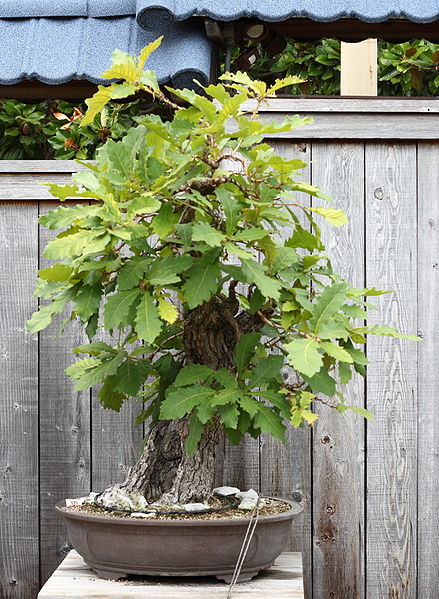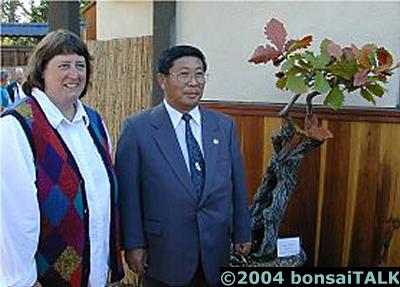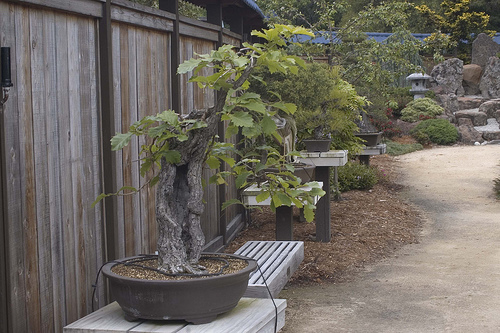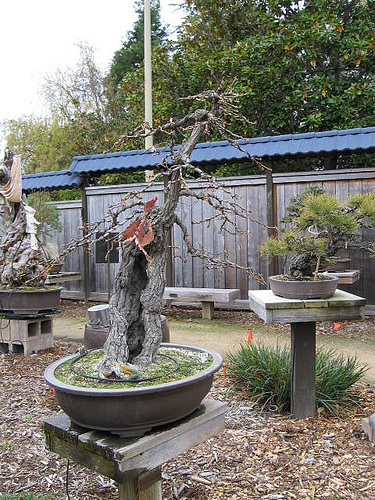

|
The Daimyo Oak A dwarfed potted Daimyo Oak (Quercus dentata), also known as the "Abraham Lincoln" tree, is believed to be the first bonsai to have been brought into the United States and the "oldest DOCUMENTED bonsai" in this country. It is said to have been presented to Anson Burlingame by the Emperor of Japan. Obviously this tree had a certain age and status as a bonsai that the Emperor of Japan would present to visiting dignitaries. Daimyo Oaks aren't necessarily currently considered good bonsai material because they have rather large leaves which don't reduce in size with the bonsai process; but styles and tastes change. When this tree was presented to Burlingame it was acceptable to have bonsai with large leaves. The tree spent most of its life as a patio tree growing in a large "100 year-old egg" container. At some point many years ago, Dr. Gotcher acquired it from a member of the Burlingame family. (This Dr. Gotcher?) (How did he first learn about this tree and what were the circumstances of his acquiring it? Are there any articles about the Burlingame's or Gotcher owning the tree? How was its [alleged] history preserved and passed on?) When the National Arboretum in Washington, D.C. opened the North American Collection of Bonsai in 1991, the tree was offered to them but was turned down because the tree had overgrown (was too large) and had "grown out" of it's training pattern. When the Collection-North opened (November 6, 1999), the tree was then offered to the Collection, and the Curator, Kathy Shaner, gladly accepted the tree. (How did Gotcher learn about the Collections and did any other bonsai enthusiasts know about the tree before it was finally offered?) It was over eight foot tall and quite "scraggly"....but Kathy began a program of training and nurturing. The trunk, meanwhile, had its dead hardwood reamed out. A contemporary description states that "Now a furrowed and hollow trunk that has grown without any restraining binding for many years, its few browned oak leaves gracing its topmost branch like a rooster's comb, the gnarly tree rests humbly in a black metal tub at the newly opened Bonsai Garden at Lakeside Park in Oakland." (BTW, the Collection has more recently accepted two other, younger Daimyo Oaks and most people do find them attractive, even with their large leaves...) 
Kathy Shaner, her teacher Yasuo Mitsuya, and the Daimyo Oak, at GSBF Collection - North (photo by Matt Chroust) ©2004 Bonsai Talk (http://wiki.bonsaitalk.com/index.php/Image:Yasuo_mitsuya.jpg) By the time of the above picture, the tree's height had been cut down and the two upward growing branches are visible. Kathy then slowly bent down one of the branches with wire, re-bar and scaffolding. This resulted in new side-growth at the base of the branch. The other branch remained upright but was positioned to be more of an apex. At some point when Kathy was away on travels, one of her assistants is said to have decided to check the positioning of the bent-down branch by removing the scaffolding and supporting wire and re-bar. Finding that the branch remained down in place, the tree was left as it was. A squirrel came by, jumped on the tree, and then on the branch -- irreparably breaking the branch. (Are there any older photos of this tree?) 
Bonsai Quercus Dentata Daimyo Oak April 27, 2005 (http://www.flickr.com/photos/tofu_1/2811032877/)
The Daimyo Oak has been completely restyled by Master Yasuo Mitsuya in September, 2009. (http://www.gsbf-bonsai.org/lake-merritt/Garden_photo1.htm) 
Daimyo Oak Bonsai -- New Year's Day 2010 (http://www.flickr.com/photos/35125373@N05/4234511565/) Per Kathy Shaner, 06/19/2010, this photo is not centered on the "front" of the tree. In addition to its historical significance, the tree also teaches us some other things... that the living part of the tree is the bark, because the entire interior of this tree has been rotted out, and it's something like a "tube" of bark [whose edges are almost completely healed over] which is growing and vibrant. 1 When Did It Come Here? Burlingame was in China actually as U.S. Minister from October 1861 through 1865, and then late 1866 through February 1868 (see below). The caption at the source to the first picture above also states that "The tree was a gift to the United States envoy to China, Mr. Burlingame, in 1863." The listing for the Garden BGLM states for this tree "In 1863, during Lincoln's presidency, Mr. Burlingame was envoy to China. This tree was a gift to him as he passed through Japan on his return to the United States." This is repeated on a few other sites referencing the Garden. Furthermore, in the October 2009 article "Big trees inspire Oaklanders to make small versions; Bonsai Garden at Lake Merritt: Where old trees go to find new life in a tranquil setting" by Lee Cressey (Laney Tower), it is stated that "In 1863, the U.S. Ambassador to China stopped in Japan on his way back to the states, where he received this plant and gave it as a gift to the then sitting President Lincoln." As with most historical events, though, the "rest of the story" details become messy. Our researches have so far not turned up an 1863 reference to the ambassador, nor any mention of Pres. Lincoln ever seeing this oak. We are endeavoring to fill in the missing history. What we have discovered is this: On March 17, 1863, President Lincoln and his wife, Mary, toured the Patent Office [whose museum also was still serving as a Union hospital at the time]. A newspaper reported, "This temple of American genius has lately received additions... Mrs. Lincoln, with characteristic unselfishness, has sent from the White House a splendid variety of the presents of the Kings [sic] of Siam and the Tycoon of Japan. Among the most noticeable is a suit of Japanese armor... for which the Knight of La Mancha would have given his boots... The President and Mrs. Lincoln seemed to enjoy greatly this respite from the cares of State [for example] among so many interesting objects." (New York Herald, 20 March 1863, 4:5.) "Tycoon" was a Western term for shogun, the supreme military general who was also known outside Japan as the "secular emperor," in contrast to the hereditary Emperor or Mikado. The shogun at the time was the 17-year-old Tokugawa Iemochi (who, incidentally, was married to the younger sister of Emperor Kōmei and would die three years later from heart failure due to beriberi, a disease caused by thiamine (vitamin B1) deficiency -- too much polished rice?) His successor would be the short one-year reigning and final Tokugawa shogun Yoshinobu. (The King of Siam, at the time, was Rama V, aka Chulalongkorn -- son of the title ruler in the semi-fictionalized Anna and the King saga. Although the U.S. and Siam/Thailand have had treaty relations since 1833, the first American envoy to Siam was not appointed until 1882. And, finally, Tsuneyo Genzayemon's story in Hachi-No-Ki would have been a more appropriate reference with the Japanese armor than Don Quixote's, but the former tale would not be known in the West for at least another three decades.) "Daimyo" is a generic term referring to one of the powerful territorial lords in premodern Japan who ruled most of the country from their vast, hereditary land holdings. The Emperor from 10 March 1846 to 30 January 1867 was Kōmei. It should be noted that Emperor Kōmei never saw any foreigners in his lifetime and he knew little about them. During his reign he started to gain more power as the Tokugawa Shogunate declined, though this was limited to consultation and other forms of deference according to protocol. He generally agreed with anti-Western sentiments, culminating on March 11 and April 11, 1863 with his "Order to expel barbarians," although the Shogunate had no intention of enforcing the order. (The future Meiji Emperor was Kōmei's second son by his consort Nakayama Yoshiko, but the young prince was the only one of Kōmei's six children to survive past the age of two.) Robert H. Pruyn was U.S. Minister to Japan from 1861 to 1865. Be that as it may, we have not yet found reference that these 1863 gifts included any live specimens -- or that they were in anyway associated with Burlingame. Based on the above details, the tree would have been a present from the Empire of Japan, by way of the workings of the Shogun, not the Emperor. Per correspondance with Secretary of State William H. Seward, Burlingame was in Peking on March 11, 1865 and in Shanghai from at least April 22 through May 7. (One letter from Burlingame to Prince Kung is posted as being from the Legation of the United States, Peking on May 5, though...) And a final note from Burlingame to Seward that year is shown as being written in Washington and dated November 27, 1865. We've also come across mention, without further details so far, that "During an absence on leave in America between the spring of 1865 and the autumn of 1866, Mr. Burlingame was able to advise the department of state upon the condition of affairs and to discuss with the secretary some proposals for future activity in China." We are attempting to find info about Burlingame in Japan on his way home to the U.S., apparently sometime after about mid-May 1865. Still, President Lincoln had been assassinated, dying the morning of April 15, without there being any evidence of his having seen this daimyo oak. Evidence for Burlingame in Japan is found thusly: The U.S.S. Wachusett reached Yokohama from Shanghai on August 23, 1866. "Saturday morning, September 1st, the Hartford, Wyoming and Wachusett, left Yokohama and went up to Yeddo [aka Edo, later renamed Tokyo], some fifteen miles distant, our business there being to take up General R.B. Van Valkenburgh, [third] United States Minister to Japan [who had been a member of Congress for a number of years and had served with distinction in the Civil War. He was by training and disposition well suited to carry on the American policy toward Japan, which had been formulated so well by Townsend Harris. On August 12, 1866, he arrived at his post] and Legation. Before we arrived there, the marines of the vessels had donned their uniform dress, and had everything bright and shining in readiness to go ashore, agreeable to orders received before leaving Yokohama. "Precisely at 1 P.M., the barge shoved off from the Hartford, bearing General Van Valkenburg, and wife, child, and female servant, his chief of staff and secretary, with Hon. Anson Burlingame, United States Minister to China. As soon as they were clear, the Hartford thundered forth the ministers' salute of fifteen guns. Beside the barge another boat left the Hartford, one from the Wyoming and one from us, bearing the marines from the respective vessels." (pp. 222-223) [As childless Tokugawa Iemochi died on August 29, 1866 at Osaka, but his death was not announced until September 28 so that his successor could be lined up, Burlingame -- if he did meet with a shogun -- could not have met with Iemochi at this stop. And Yoshinobu, his successor, was not invested to the office until January 10, 1867 at Kyoto.] Our travellers then went back to Yokohama on September 9 for provisions (pg. 227). "We left Yokohama September 13th, for Nagasaki [by crossing the Inland Sea], having Mr. Burlingame on board as passenger." (pg. 228) [There is no further mention of Burlingame in this record. Burlingame did later write Secretary of State Seward from Peking on December 12, 1866 (referring to a November 20 interview the Minister had with Prince Kung.) And Pres. Lincoln had been dead almost a year-and-a-half by now. The remainder of this voyage is briefly mentioned here to show you how convoluted it was and how unlikely that a gifted tree would have been on this passage.] The ship left Nagasaki on September 24 and arrived in Hong Kong on September 29. On October 13 they went up to Macao until the 16th (pg. 236). They returned to Hong Kong on October 20 (pg. 238). On November 3 left for various sites including Amoy (where there were upwards of five hundred European residents, for the most part merchants and their families, per pg. 250), returning to Hong Kong on November 29 a day after leaving Amoy (pg. 243). To Shanghai on January 6, 1867; in Chefoo on January 22 (pg. 269); on February 2 in Port Hamilton, Corea (pg. 277). [Emperor Kōmei died of smallpox on February 3. His successor, later to be known as the Meiji Emperor, would take the throne ten days later, but his reign would not officially start until October 23, 1868. Burlingame wrote to Secretary of State Seward from Peking on February 9, 1867.] The Hartford went back to Shanghai on February 5 until the 25th (pg. 285), and then inland to Hankow by March 6 (pg. 290). Left Nankin on March 29 for one-day trip to Shanghai (pg. 304). Left for Foo-chow on April 3 (pg. 306), on April 13 heading for Ninpo (pg. 309), and making Shanghai by April 24 (pg. 319). Left on July 29 to the sacred island of Pootoo (pg. 347) and then to Shanghai, which was left on August 26 for Hong Kong (pg. 363). In Hong Kong by Sept. 11 (pg. 362). Lawrence was transferred to U.S. Flag-Ship Hartford around September 13 (pg. 369). "October 5th the Great Republic arrived here from San Francisco, deeply laden with California products. She brought our mails and home news up to September 3rd. On her return trip she takes out a large cargo of tea and silks, with about seven hundred Chinese steerage passengers, besides about one hundred Europeans in her cabins." (pg. 374). The Hartford left Hong Kong on October 10 (pg. 375) and were in Nagasaki from October 20 until December 16 (pg. 380). On December 17 they were at Simonosaki. "The Japanese are passionately fond of flowers, and the dwarfing of shrubs and trees is carried by them to a high state of perfection. Of the latter I saw some of the finest specimens at Simonosaki [on the northern side of the straits at the entrance to the Inland Sea]. I saw a number of perfect oaks, upward of fifty years old, that were scarcely more than six feet high, and fifteen in circumference at the point where the branches were most wide spread. I also noticed several pines, dwarfed in equal proportion, and with the additional interesting feature that the branches were trained to grow in a nearly horizontal direction, instead of having an upward tendency as is natural. Other trees and shrubs I saw, dwarfed, and with their trunks tied in curious knots, or with their branches pruned and trained so as to represent some desired profile or character." (about December 18, per January 20, 1868 letter, pg. 381) The Hartford arrived at Nagasaki on January 26, 1868 and was there until February 1 (pg. 396). Taking a week to reach Hong Kong, the crew was at that port till March 5 (pg. 397), then to up Whampoa (pg. 402). Back to Hong Kong until March 21 when it headed out for a ten day voyage to Singapore (pg. 412). The vessel left on April 23, and the now U.S.S. Hartford reached South Africa at the start of June (pg. 421). Finally, the crew reached New York on August 6 after an absence of forty-one months (pg. 436). This would have been an extraordinarily long and probably fatal voyage for the Daimyo Oak if it had, indeed, gone this entire route. What route did the dwarfed tree actually take and when? Did Burlingame arrange for the oak's passage from Japan on some other ship? Was the tree shipped directly to San Francisco from Japan, or was there a side trip to Hong Kong or Singapore? Was there a visit to Japan in 1863 by Burlingame that we have not yet discovered? Our researches are continuing... 2 |